We start the new week with the following stories...
Be safe out there!
Tom
Passengers evacuated from plane onto Denver runway after landing gear issue sparked fire and left 1 injured
Dalia Faheid, Jordan Brown, CNN
(CNN) — More than 150 passengers on an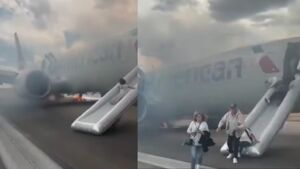 American Airlines flight departing from Denver International Airport Saturday were evacuated onto the runway after a “possible landing gear incident” left one person injured and sparked a fire, according to the Federal Aviation Administration.
American Airlines flight departing from Denver International Airport Saturday were evacuated onto the runway after a “possible landing gear incident” left one person injured and sparked a fire, according to the Federal Aviation Administration.
After the Boeing 737 MAX 8 experienced a “maintenance issue” involving an aircraft tire prior to takeoff, emergency personnel at the airport and the Denver Fire Department responded to the issue and those on board were evacuated on the runway, according to American Airlines and Denver International Airport.
The evacuation is the latest in a string of alarming aviation incidents at Denver International Airport – the sixth busiest airport in the world. In March, dozens of passengers were forced to stand on the wing of an American Airlines plane as they evacuated the aircraft after one of its engines caught fire. A month later, a United Airlines plane hit an animal on takeoff and shot out fire.
On Saturday, passengers on the plane, which was departing to Miami International Airport with 173 passengers and six crew members, panicked when they heard a loud bang and saw flames before being evacuated on a slide attached to the plane.
The combination of blown tires and the deceleration of the plane during braking resulted in a brake fire that was extinguished by the Denver Fire Department, according to American Airlines.
“All customers and crew deplaned safely, and the aircraft was taken out of service to be inspected by our maintenance team. We thank our team members for their professionalism and apologize to our customers for their experience,” the airline said.
Five people were evaluated at the scene, and another person was evaluated at a gate and taken to the hospital with a minor injury, according to the airport and airline.
The plane had been scheduled to depart from the gate at 1:12 p.m. local time, according to FlightAware, and the incident occurred around 2:45 p.m., the FAA said. FlightAware data shows 240 flights out of Denver International Airport were delayed as of Saturday evening.
Customers will depart to Miami on a replacement plane later today, according to the airline. The FAA is investigating the incident.
The evacuation comes a day after a harrowing moment for passengers on a Southwest Airlines flight. A privately owned Hawker Hunter fighter jet crossed less than two miles in front of a Boeing 737 plane within a few hundred feet of its altitude, according to the flight tracking site Flightradar24.
Passengers heard a loud bang during ‘traumatizing’ incident
Shay Armistead, a 17-year-old passenger from Minturn, Colorado, who was headed to Santiago, Chile, for a ski trip with her club team, said Saturday’s ordeal was “kind of traumatizing.”
As the plane moved down the runway, passengers heard a loud bang and believed the tire popped, Armistead said.
“The plane started vibrating and shaking really bad,” she told CNN. “We started tilting to the left side of the runway, and then we heard the sound of the wind from them lifting up the brakes of the plane and slamming on them really hard.”
Just a few seats down, Armistead’s teammate, 16-year-old Margaret Gustafson, had a clear view out of the window and saw the maintenance issue, she said.
Gustafson said she knew something was wrong when she saw flames coming out from under the plane.
“That’s when I started fully panicking,” she said.
When she heard a big boom, Gustafson was unsure where the noise came from.
“Some of us just thought we hit something and then we started really swerving on the runway,” Gustafson said. “I personally grabbed my friend’s hand who was in front of me because we didn’t really know what was going on.”
The scary moment was met by immense panic among passengers.
“One passenger was screaming, ‘We’re all gonna die,’” Armistead said. “Another passenger was not sitting down and cooperating, and so it was kind of just a lot of panic.”
Passengers lined up the back of the plane, where they slid down the slide attached to the plane, Armistead said. The entire evacuation process took about 10 to 15 minutes, she recalled.
Although their ski trip plans were derailed, the teammates’ flight was rescheduled to tomorrow morning.
Virgin Australia plane damaged in collision with tug vehicle at Melbourne Airport
A Virgin Australia plane has collided with a tug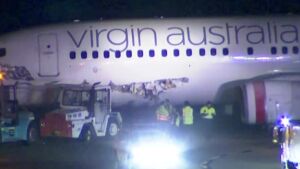 vehicle at Melbourne's Tullamarine airport.
vehicle at Melbourne's Tullamarine airport.
The aircraft disconnected and hit the tug from the side at about 8:40pm on Sunday while it was being towed to the hangar for scheduled maintenance.
A Melbourne Airport spokesperson said no passengers were on board and no ground staff were injured.
The plane impacted was a Boeing 737, typically used on Virgin's domestic routes.
Footage showed the jet cracked along the front left side, with workers taping up the damage.
Virgin Australia said it did not expect any disruptions to scheduled flights on Monday.
The Transport Workers Union (TWU) said the incident spoke to a wider "crisis" in Australia's aviation industry.
"We're seeking an urgent briefing now with Virgin to discuss how these incidents can be avoided in future — and in the meantime calling on all participants in aviation to work towards a better industry," TWU National Secretary Michael Kaine said.
https://www.abc.net.au/news/2025-07-28/plane-hits-tug-vehicle-at-melbourne-airport/105579874
B.C. company ‘devastated’ by loss of life in plane crash near Deer Lake
By Web Team
A B.C.-based company is expressing condolences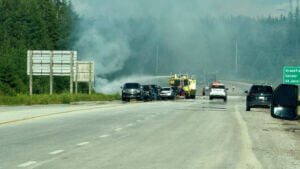 to the families of the deceased after a plane crash near Deer Lake Saturday.
to the families of the deceased after a plane crash near Deer Lake Saturday.
“We are devastated and heartbroken by this loss,” Andrew Naysmith, the owner and accountable executive of Kisik Aerial Survey Inc., posted on the company’s web page. “The incident happened at approximately 17:37 NDT on July 26 shortly after C-GYYP departed from Deer Lake Regional Airport in Deer Lake, NL. Our thoughts and deepest sympathies go out to the families of the deceased and their loved ones. No further details about the incident are available at this time. We will not be releasing the names of anyone involved with this incident, that information will be provided by the proper authorities. The cause of the accident is under investigation by the Transport Safety Board of Canada and Kisik will support that investigation in any and every way possible.”
The RCMP are helping the TSB in response to the crash.
Police say there is currently no risk to public safety. The Trans-Canada Highway was closed in both directions in the area of the Deer Lake Airport, but has since re-opened.
The Deer Lake Regional Airport Authority posted on Facebook that operations continue.
“This afternoon there was an incident near the airport and emergency crews have responded,” the authority wrote. “Our airport continues to operate and flights are arriving and departing. Thank you for your cooperation as emergency crews respond.”
https://ntv.ca/police-and-tsb-respond-to-aircraft-crash-near-deer-lake/
Emergency crash landing in Hayden leaves plane in flames, no injuries reported
Northern Lakes Fire Protection says there were three passengers on board during the crash. No one was injured.
Author: Taylor Nichols
HAYDEN, Idaho — A small plane crashed in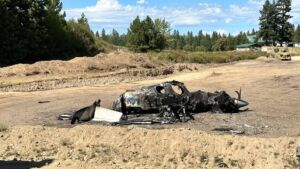 Hayden Sunday morning with three people on board, according to Northern Lakes Fire Protection (NLFP).
Hayden Sunday morning with three people on board, according to Northern Lakes Fire Protection (NLFP).
Coeur d'Alene Aviation and Maintenance says on their Facebook page that they got a report of a plane that crashed just outside of the Coeur d'Alene Airport around 10:15 a.m. Sunday. They say the plane that crashed was not one of theirs.
NLFP says that it was a single-engine aircraft and they had an emergency crash landing, which later became engulfed in flames.
NLFP says that the three passengers onboard were able to safely get out without any injuries before the plane caught on fire.
https://www.krem.com/article/news/local/emergency-crash-landing-hayden-leaves-plane-flames-no-injuries-reported/293-3fd2acd5-4b70-494c-b459-ee606fb0aa27
NTSB Final Report: Kubicek BB85Z
During The Descent The Envelope Continued To Deflate Until It Was In A Streamer-Type Configuration
Location: Eloy, Arizona Accident Number: WPR24FA072
Date & Time: January 14, 2024, 07:47 Local Registration: N4961D
Aircraft: Kubicek BB85Z Aircraft Damage: Substantial
Defining Event: Loss of control in flight Injuries: 4 Fatal, 1 Serious, 8 None
Flight Conducted Under: Part 91: General aviation - Other work use
Analysis: The balloon departed with the pilot, eight skydivers, and four passengers on a sightseeing passenger and skydiving (commercial) flight. Interviews with the skydivers revealed that after about 35 minutes, the balloon reached an altitude of about 10,000 ft mean sea level (msl) and all 8 skydivers departed from the basket in 4 groups numbering 3, 2, 1 and 2 jumpers, respectively. The four passengers and pilot remained in the basket. After the jumpers exited the basket, the pilot pulled the red rapid deflation valve line 12 times to open the rapid deflation valve. This action resulted in a rapid loss of air that deformed the envelope, causing the deflation system’s control lines to drop in and around the basket, which pinched the Red-White line in the flying cables. About 46 seconds later, the pilot attempted to add hot air to the envelope and attempted to close the rapid deflation valve but, was unsuccessful. During the descent the envelope continued to deflate until it was in a streamer-type configuration.
Additionally, at times a burner flame under the deflated envelope was observed, as the pilot attempted to inflate the balloon envelope. The balloon continued to descend until it impacted the terrain.
Witnesses saw the balloon descending toward the ground. A review of multiple mobile phone videos revealed that the balloon was descending with the envelope deflated and trailing above the basket. Postaccident examination of the balloon did not reveal any preimpact anomalies that would have precluded normal operation. According to the balloon flight manual, the rapid deflation system was designed for fast and efficient deflation of the envelope during landing below 6.5 ft above ground level to prevent the basket from being dragged in windy conditions. If the pilot had used the parachute valve to manage the descent, he likely would have been able to land the balloon without injuries. Several online videos showed the pilot using the rapid deflation system while at high altitudes in other flights, indicating that that this was a common practice for him.
Probable Cause and Findings: The National Transportation Safety Board determines the probable cause(s) of this accident to be -- The pilot’s decision to open the rapid deflation valve during flight as a means of descending, which resulted in the deflation of the envelope and hard impact with terrain.
FMI: www.ntsb.gov
NTSB Final Report: Luce Buttercup
The Airplane Broke Up In Flight And Descended To The Ground. The Debris Path Extended For About 1,435 Ft.
Location: Lyndonville, New York Accident Number: CEN23FA204
Date & Time: May 28, 2023, 18:15 Local Registration: N18263
Aircraft: Luce Buttercup Aircraft Damage: Destroyed
Defining Event: Aircraft structural failure Injuries: 2 Fatal
Flight Conducted Under: Part 91: General aviation - Personal
Analysis: The pilot, who was the owner and builder of the experimental, amateur-built airplane, departed with a pilot-rated passenger on a 15 to 20-minute local flight. Witnesses reported that the airplane broke up in flight and descended to the ground. The debris path extended for about 1,435 ft, beginning with debris from the wings, consistent with failure related to the wing structure.
Postaccident examination of the engine and propeller revealed no mechanical anomalies that would have precluded normal operation. No preimpact flight control deficiencies were found. There was no evidence of flutter. The wing separations were consistent with upward and aft bending and/or torsional loading based on deformation signatures of the wing attachment brackets, strut brackets, and front strut attachment fittings (outboard end). Fracture surfaces of the wing attachment brackets and front strut fittings were consistent with overstress separation. No flight track information was available for the accident flight.
The pilot built the airplane based on dimensions from another airplane for which no plans had been produced. The accident airplane was issued a special airworthiness certificate about 21 years before the accident. At the time of the accident, the airplane had been modified from its original configuration with the installation of a heavier, higher-horsepower engine and the installation of a different propeller. Because no maintenance records were located for the airplane, there was no information available regarding this modification, the airplane’s operational time, or its inspection/maintenance history.
The airplane’s design/build plans were not based upon a structural engineering analysis to determine a structural design envelope, structural loads, or structural performance. Accordingly, the basis for any design safety margins and limitations are unknown. There were no regulatory design requirements for the airplane due to its experimental classification.
Metallurgical examination revealed no conclusive evidence of pre-existing or progressive damage signatures that would have initiated the accident, and fractured structural components were consistent with overstress separation. One small area of possible fatigue fracture was observed emanating from the weld face on the lower-forward left strut end fitting at the outboard end; however, based on the amount of deformation observed in this area, it was not a likely fracture initiation point.
The pilot’s toxicological testing detected several volatile solvents; however, the volatile solvent levels measured in the pilot’s tissues cannot be used to reliably predict the route of his exposure or specific effects. Thus, whether the pilot had inhaled volatile solvents recreationally or was experiencing any impairing effects of volatile solvent exposure, could not be determined. Toxicological testing also detected ethanol in liver tissue; n-butanol (a potential
indicator of postmortem microbial activity) was also detected in this specimen; however, it is likely that the detected ethanol was from sources other than alcohol consumption and did not likely contribute to the accident.
The pilot’s toxicology results also demonstrated the presence of central nervous system depressant medications, including cyclobenzaprine and gabapentin. Cyclobenzaprine use may be associated with significant performance impairment. Use of gabapentin can also increase the user’s somnolence, dizziness and fatigue, potentially impairing pilot performance. Both cyclobenzaprine and gabapentin have potential postmortem redistribution; therefore, reliably associating levels with impairing effects is not possible. Overall, whether the pilot’s use of cyclobenzaprine and gabapentin contributed to the accident cannot be determined.
The pilot-rated passenger’s mild-to-moderate coronary artery disease conveyed some increased risk of a sudden impairing or incapacitating cardiac event, including angina, arrhythmia, or heart attack. There is no autopsy evidence that such an event occurred. However, such an event does not leave reliable autopsy evidence if it occurs immediately before death. The aircraft was configured such that it could be controlled from either the left or right front seat. Thus, it is unlikely that the pilot-rated passenger’s coronary artery disease contributed to the accident.
In addition, the pilot-rated passenger’s toxicological testing indicated use of citalopram and diazepam. Citalopram and diazepam, and conditions that may be treated with these medications, can adversely affect pilot performance and judgment. However, it is unclear if the pilot-rated passenger’s performance or judgment were a factor in the outcome; whether effects of the pilot-rated passenger’s use of citalopram and diazepam or of any associated underlying conditions contributed to the accident cannot be determined.
Although the available information is consistent with an in-flight failure of the wing structure due to overload, given the lack of flight track information or recorded data from onboard the airplane, the circumstances of the in-flight breakup could not be determined.
Probable Cause and Findings: The National Transportation Safety Board determines the probable cause(s) of this accident to be -- An in-flight breakup due to structural overload of the airplane for undetermined reasons.
FMI: www.ntsb.gov
NTSB Prelim: Filby Gerry RV-9
Engine Made A Pronounced Sound For About 2 Seconds, And Then Both The Oil Pressure And Fuel Pressure Rapidly Decreased
Location: Morgan Hill, CA Accident Number: WPR25LA188
Date & Time: June 23, 2025, 12:17 Local Registration: N696WG
Aircraft: Filby Gerry RV-9 Injuries: 1 Minor
Flight Conducted Under: Part 91: General aviation - Personal
On June 23, 2025, about 1217 Pacific daylight time, an experimental amateur-built Vans Aircraft Inc RV-9 airplane, N696WG, was substantially damaged when it was involved in an accident near Morgan Hill, California. The pilot sustained minor injuries. The airplane was operated as a Title 14 Code of Federal Regulations Part 91 personal flight.
The pilot reported that about 4,500 ft mean sea level, the airplane’s engine made a pronounced sound for about 2 seconds, and then both the oil pressure and fuel pressure rapidly decreased to zero. The engine initially continued to operate, but shortly afterwards lost all power. Unable to make it to an airport, the pilot made a forced landing on an open field. During the landing sequence, the pilot maneuvered the airplane to avoid a sports track, and one of its wheels struck a berm which resulted in substantial damage to the wings.
The airplane was recovered and retained at a secure facility for further examination.
FMI: www.ntsb.gov
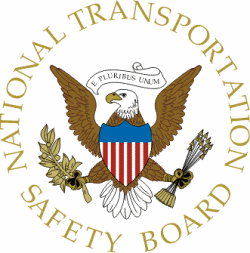
Today in History
15 Years ago today: On 28 July 2010 Airblue flight 202, an Airbus A321, crashed while on approach to Islamabad-Benazir Bhutto Airport, Pakistan, killing all 152 occupants
| Date: | Wednesday 28 July 2010 |
| Time: | 09:41 |
| Type: | Airbus A321-231 |
| Owner/operator: | Airblue |
| Registration: | AP-BJB |
| MSN: | 1218 |
| Year of manufacture: | 2000 |
| Total airframe hrs: | 34018 hours |
| Cycles: | 13566 flights |
| Engine model: | IAE V2533-A5 |
| Fatalities: | Fatalities: 152 / Occupants: 152 |
| Other fatalities: | 0 |
| Aircraft damage: | Destroyed, written off |
| Category: | Accident |
| Location: | 15 km NNW of Islamabad-Benazir Bhutto International Airport (ISB) - Pakistan |
| Phase: | Approach |
| Nature: | Passenger - Scheduled |
| Departure airport: | Karachi-Jinnah International Airport (KHI/OPKC) |
| Destination airport: | Islamabad International Airport (ISB/OPRN) |
| Investigating agency: | PakCAA |
| Confidence Rating: | Accident investigation report completed and information captured |
Narrative:
Airblue flight 202, an Airbus A321, crashed while on approach to Islamabad-Benazir Bhutto Airport, Pakistan, killing all 152 occupants
Flight ED202 had departed Karachi International Airport (KHI) on a domestic service to Islamabad.
Weather at Islamabad was poor with deteriorating visibility. A PIA flight had landed on the third attempt to land and a flight from China had returned. ABQ202 was cleared for a runway 12 Circling Approach procedure. During the approach the captain descended below Minimum Descent Altitude (MDA) (i.e. 2,300 ft instead of maintaining 2,510 ft), losing visual contact with the airfield. The captain then decided to fly a non-standard self-created PBD (Place Bearing Distance, RNAV waypoint)-based approach, thus transgressing out of the protected airspace by an distance of 4.3 NM into the Margalla Hills area.
The captain did not take appropriate action following calls from the first officer. He also did not respond to 21 EGPWS warnings related to approaching rising terrain and pull up.
The airplane flew into the side of a mountain. The first officer remained a passive bystander in the cockpit and did not participate as an effective team member failing to supplement and compliment or to correct the errors of his captain assertively due to the captains behaviour in the flight. The investigation report said that during initial climb, the captain tested the knowledge of the first officer and used harsh words and a snobbish tone, contrary to the company procedure/norms. The question/answer sessions, lecturing and advices by the captain continued with intervals for about one hour after takeoff. After the intermittent humiliating sessions, the FO generally remained quiet, suffered from underconfidence, became submissive and subsequently did not challenge the captain for any of his errors, breaches and violations.
FINALIZATION: "Air blue crash has been finalized as a case of Controlled Flight into Terrain (CFIT), in which aircrew failed to display superior judgment and professional skills in a self created unsafe environment. In their pursuit to land in inclement weather, they committed serious violations of procedures and breaches of flying discipline, which put the aircraft in an unsafe condition over dangerous terrain at low altitude."
METAR:
03:00 UTC / 08:00 local time:
OPRN 280300Z 05016KT 2000 RA FEW015ST SCT040 BKN100 FEW030TCU 24/23 1006.5=
Wind 050 degrees at 16 knots; 2000m visibility; rain; few clouds at 1,500 ft, few clouds at 3,000 ft with Towering CB, scattered clouds at 4,000 ft, broken clouds at 10,000 ft.; Temperature 24°C, dew point 23°C
04:00 UTC / 09:00 local time:
OPRN 280400Z 05016KT 3500 SCT010 SCT030 BKN100 FEW030TCU 29/24 1006.7=
Wind 050 degrees at 16 knots; 3500m visibility; scattered clouds at 1,000 ft and 3,000 ft, few clouds at 3,000 ft with Towering CB, broken clouds at 10,000 ft.; Temperature 29°C, dew point 24°C
05:00 UTC / 10:00 local time:
OPRN 280500Z 09018KT 3500 RA SCT010 SCT030 OVC100 FEW030 25/24 Q1006.9=
Wind 090 degrees at 18 knots; 3500m visibility; rain; scattered clouds at 1,000 ft and 3,000 ft, overcast at 10,000 ft.; Temperature 25°C, dew point 24°C
